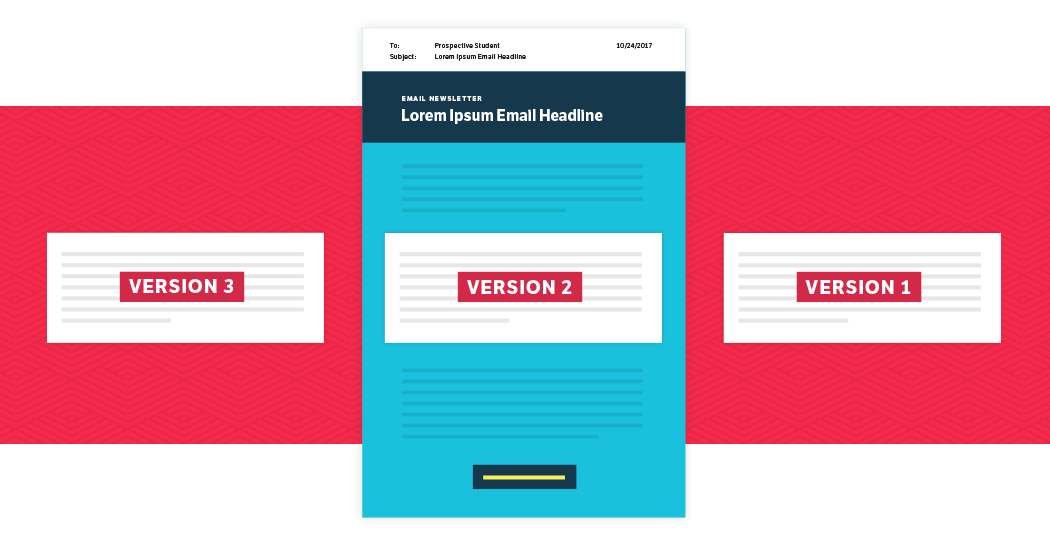Keeping communication relevant and personalized throughout the entire decision-making process is a critical objective for higher education recruiters.
But how do we speak authentically to multiple groups of students without it becoming an overwhelming task?
One solution: segmentation and marketing automation.
Tools like Pardot, Marketo and HubSpot allow marketers to say, “When a group of students behaves a certain way, put them in this bucket. If they behave another way, put them in a different bucket. And if they do a particular thing along the way that changes which bucket they should be in, automatically move them from one bucket to the other.”
From there, we can personalize the messaging to each segment, ensuring your school’s communications remain relevant no matter what pace each student moves through their personal decision-making process.
 How Segmentation Works
How Segmentation Works
Recently, we worked with Saint Leo University to solidify their undergraduate recruitment sales funnel, creating segments that would to allow us to configure marketing automation workflows using SalesForce and Pardot. We identified well-defined actions connected with the natural inquiry and admission process that students go through. This let us instruct Pardot that if a student was in a particular bucket, to send them a series of messages until they performed an action that indicated they had moved to a different decision-making stage.
Once we had the segments defined, we got to work writing the content and designing the emails. In the end, we wrote 362 unique email messages. There are multiple messages for each segment designed to speak to their unique concerns and motivations and continually push them to move to the next stage of the funnel. Here’s what that process looked like for Saint Leo University:
- Prospect – These students have zero previous interaction with the university. We want to introduce the big-picture selling points and give them ample opportunities to connect and engage by completing easy info-request forms, scheduling a campus visit or following us on social media.
- Inquiry – These students have shown initial interest, but have not begun the application process. At this point, we are actively encouraging them to apply.
- Application Started – Many students start an application but don’t complete it. This messaging segment gives reasons why they should finish with an emphasis on making it easy for them to provide feedback if they need technical or other support from the admissions team.
- Application Completed – These emails encourage the students to send in their supporting documentation, the final step needed for an admissions decision.
- Accepted – Students are often accepted into many colleges or universities. Messaging from this segment gives them personalized reasons to officially choose Saint Leo.
- Deposited – These messages continue to make it easy for students as we guide them through the process of depositing, all the way through to attending their first class. We’re laying the groundwork for engaged students who will stay at the school through graduation.
Taking it to the Next Level
Segmentation provides a firm foundation for marketing automation, but the real magic happens when you take it a step further. Using the technology built into tools like Pardot, we can customize messaging based on what students have indicated interest in—even within the decision-stage buckets.
For example, take two students who have started applications but haven’t finished them—one is interested in biology and another is interested English. During the recruitment campaign, we send both students the same email, except we’ve used custom content to change a paragraph within the email to be about their interests.
Not only will a student get specific messaging about the program they’re interested in, they might also get information on relevant clubs and related study abroad programs—all specific things that pertain to that department.

With marketing automation, you can drill down as far as you want. You can customize a message based on any data point you have on an individual. Doing this makes a single message—which goes out to thousands of people—relevant to each individual student based on what they themselves have selected.
Continuous Improvement
Despite being highly automated, we aren’t just setting up segments and automation and forgetting them.
In the example of undergraduate recruitment at Saint Leo University, our first campaign cycle presented multiple topics in each email. The following year, after looking at analytics like open rates and how long students had emails open, we decided to not only change the frequency of the emails, but to also break those multi-topic emails into single-topic ones. We found that giving students one piece of information to digest per email yielded a higher rate of engagement and resulted in a more effective overall campaign, thus allowing us to fine-tune our approach over time.
After implementing this segmented and personal approach to email marketing using Pardot, Saint Leo’s Admissions department saw a significant increase in several stages of the decision-making process. Prospective student inquiries saw a 37-percent increase from the previous recruitment cycle. Total applications rose by 15 percent. And completed applications jumped up by 24 percent.
And we’re not stopping there! At Echo Delta, we’re continuously gaining knowledge, training, research and on-the-job experience to improve our marketing automation strategies. We love finding new ways to utilize marketing automation platforms and data-driven insights to further increase the impact of the personalized experience—all with the end goal of seeing even more happy, newly accepted college and university students for our clients each recruitment cycle.


